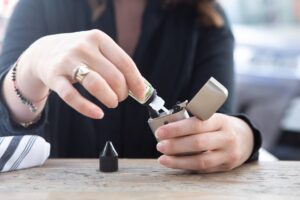
Determining which type of vaping is “safe” is not complicated, like most other retail industries you “get what you pay for” and “consider the source” (i.e. gas station vape and tobacco shops do not inherently care if you smoke or vape and their product quality will convey as much).
Quality of E-Liquids:
Opt for high-quality, lab-tested e-liquids. These are less likely to contain harmful additives and contaminants. Lab testing helps ensure the absence of harmful substances like heavy metals or diacetyl.
Nicotine Content:
Be mindful of the nicotine content. E-liquids are available in various nicotine strengths, including nicotine-free options. For those using vaping to quit smoking, reducing nicotine levels gradually might be beneficial. Non-smokers should ideally choose nicotine-free options.
Device Safety:
Use devices from reputable manufacturers. Quality devices have safety features to prevent problems like battery malfunctions.
Remember Oil-Based Vapes are NOT from Nicotine Delivery:
Lung injuries associated with vaping have been linked to oil-based vapes used for marijuana, typically due to substances like vitamin E acetate. For nicotine vaping, it’s advisable to use standard e-liquids, which are water-soluble and free from oil-based ingredients.
Regulatory Compliance:
Ensure that the vaping products comply with local regulations. Regulated products are more likely to meet established safety standards.
Avoid DIY or Modified Products:
Stay away from homemade or modified vaping products, as they can be unsafe and unpredictable.
Share this post
Recent Posts


Can Vaping Cause Cancer?
April 30, 2023

How Vaping Affects Your Body
April 30, 2023

What Vaping Does To Your Lungs
April 30, 2023

Which Vaping Is Safe
April 30, 2023
Related Post
You May Like

Are Vaping and Smoking the same?
April 30, 2023

Can Vaping Cause Cancer?
April 30, 2023

How Vaping Affects Your Body
April 30, 2023

What Vaping Does To Your Lungs
April 30, 2023
